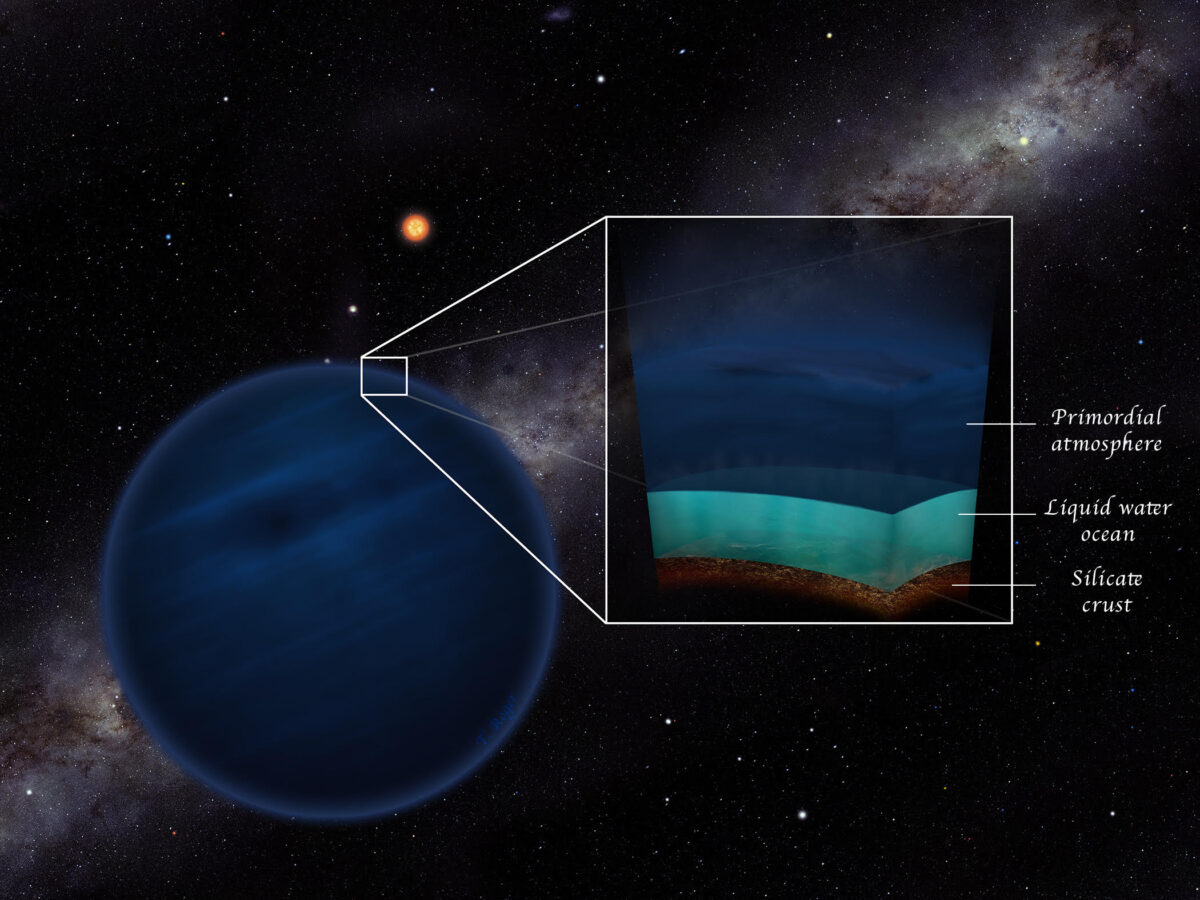

Somewhere in the universe, there may be rocky worlds perhaps twice as distant from their host stars as Earth is from the sun. So far from their stars’ warmth, these planets should be quite cold—and any water on their surfaces should be frozen.
But planetary scientists say there could be a class of rocky exoplanets covered in thick blankets of hydrogen and helium gases. If those layers insulate the planets’ cores from the harsh chill of space, their surfaces might be just the right temperature to host liquid water. And, if that’s the case, it’s possible that these worlds are habitable.
About a decade ago, scientists proposed that such worlds might be able to support life. They sometimes refer to these planets as “cold super-Earths,” because they’re probably up to 10 times more massive than our home. But the researchers hadn’t figured out whether water could stick around on these exoplanets long enough for life to evolve.
Now, new calculations described in a paper published Monday in the journal Nature Astronomy suggest that the surface conditions of these worlds could have been temperate for more than enough time for life—for 5 billion to 8 billion years. Earth is only about 4.5 billion years old, by comparison, and life emerged here about 3.7 billion years ago.
“Life needs some time to evolve. So it does matter that it has been a long period,” says Björn Benneke, a professor of astrophysics at the Institute for Research on Exoplanets at the University of Montreal who was not involved in the new study. If super-Earths only had liquid water for relatively small slices of their existence–for instance, a million years or so–it would be “discouraging” for the hypothesis that these planets may be habitable beneath hydrogen atmospheres, he says.
The new calculations bode well for the potential habitability of these cold super-Earths. Their existence is still theoretical—none have been found yet—so this adds an incentive for astrophysicists to hunt for this exoplanet class as they seek to determine whether we’re alone in the universe.
[Related: NASA’s official exoplanet tally has passed 5,000 worlds]
“It’s important to be really open-minded, and not to expect that life has to be under conditions that are just a copy of exactly Earth,” says Marit Mol Lous, lead author on the new paper and a PhD student studying exoplanets at the University of Zurich in Switzerland. “This gives us an extra argument to keep these exotic habitats in mind.”
Based on our only model of a known-habitable world, Earth, scientists often look for a planet that also orbits its star in a region where the planet’s surface is neither too hot nor too cold for liquid water. That region is often called the habitable zone, or nicknamed the “Goldilocks zone.” So-called cold super-Earths, in contrast, lie beyond their stars’ habitable zone. But that might also, counterintuitively, be part of what makes those alien worlds habitable.
On Earth, atmospheric greenhouse gases such as carbon dioxide and methane help maintain that “just right” temperature for water. Hydrogen can also act as a greenhouse gas, if there’s enough of the stuff around.
The trick is keeping that hydrogen gas around long enough for it to build up. It’s a particularly light element, so unless a planet is massive enough and has enough gravity to hold onto the gas, hydrogen will vanish into space. And if the planet is close to its star, the radiation can make those particles escape more quickly. The vast distance between these cold super-Earths and their stars could protect their hydrogen gas from being torn away.
To figure out what it would take for a cold super-Earth to maintain just the right thickness of a hydrogen-helium atmosphere over an extended period of time, Mol Lous developed computer models of various sized rocky exoplanets. She placed them at multiple distances from their simulated host stars. Then, she ran a simulation of how they might evolve over time.
Mol Lous considered factors that would affect a planet’s surface temperature such as the rate of escape, how its host star might brighten or dim over time, and the heat emanating from radioactive material in its interior.
[Related: On this blisteringly hot metal planet, a year lasts only 8 hours]
She found that the sweet spot for long-term liquid water was if the hydrogen-helium dominated atmosphere was between 100 and 1,000 times as thick as Earth’s atmosphere, the planet’s mass was one to 10 times that of the Earth’s, and it sat at least two times as far from its star as Earth does the sun.
That distance, while it makes these cold super-Earths intriguing to study, it also makes them extremely difficult for astronomers to spot. The technique that scientists usually use to detect an exoplanet relies on the world passing in front of its star. Such a transit makes the host star’s light dim slightly, which astrophysicists use to calculate the presence of an orbiting world. But, says Benneke, when a super-Earth-sized planet is orbiting so far out, it is much less likely to be aligned at the right moment to be detectable with current technology.
As such, it’s still unknown whether such super-Earths exist, he says. “But … what experts have shown is that this kind of diversity of planets, the whole range of planets that can exist is actually extremely big.” And if they do exist, many questions remain about how such a chilly, wet world might come to be. Mol Lous and her colleagues are already working on new models to explore the formation of cold super-Earths.
But the best solution to these mysteries, Benneke says, “would be to simply find these exoplanets.”
